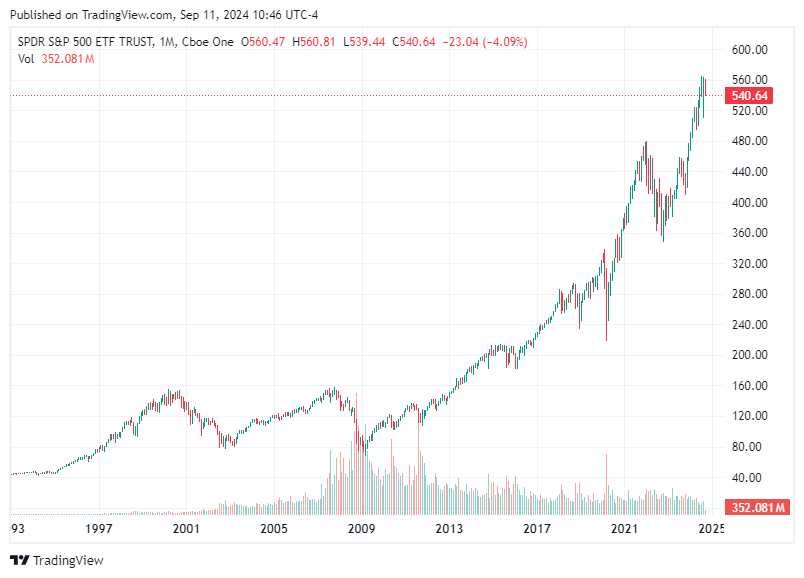
Disclaimer: This article is for informational purposes only and should not be considered financial advice. Please consult a financial professional for guidance tailored to your personal circumstances.
We are working endlessly to provide free insights on the stock market every day, and greatly appreciate those who are paid members supporting the development of the Stock Region mobile application. Stock Region offers daily stock and option signals, watchlists, earnings reports, technical and fundamental analysis reports, virtual meetings, learning opportunities, analyst upgrades and downgrades, catalyst reports, in-person events, and access to our private network of investors for paid members as an addition to being an early investor in Stock Region. We recommend all readers to urgently activate their membership before reaching full member capacity (500) to be eligible for the upcoming revenue distribution program. Memberships now available at https://stockregion.net
In August, an unexpected development emerged as core inflation figures indicated a subtle yet significant uptick. This shift has brought renewed attention to the Federal Reserve's monetary policy strategies, as stakeholders ponder the implications of these inflationary trends. At the heart of this discussion is the Consumer Price Index (CPI) report, which revealed a 0.2% rise in consumer prices and a more pronounced 3.2% increase in the core CPI, excluding the volatile food and energy sectors. These figures suggest that underlying price pressures are persisting, challenging economic projections and policy expectations.
Understanding the Rise in Consumer Prices
The 0.2% rise in consumer prices, although seemingly modest, marks a continuation of inflationary pressures that have been a focal point for policymakers and economists alike. This increase aligns with expectations, reflecting a broader trend of economic recovery and consumer demand post-pandemic. However, the core CPI's 3.2% rise over the past year, and a 0.3% monthly increase, have exceeded forecasts, drawing attention to specific sectors such as housing, which continue to exhibit stubbornly high costs.
Core inflation serves as a critical indicator for the Federal Reserve when crafting monetary policy. By excluding food and energy prices, which are often subject to volatility due to external factors like weather and geopolitical tensions, core CPI provides a clearer view of inflationary trends driven by the fundamentals of the economy. The unexpected rise in core inflation suggests that these underlying pressures are not abating as quickly as hoped, posing a challenge to the Federal Reserve's inflation-targeting strategy. The Federal Reserve's mandate involves balancing inflation and employment levels to foster economic stability. With the core inflation rate rising, the prospect of a rate cut, such as a 50-basis point reduction, becomes less likely. Instead, the Federal Reserve may opt for a more cautious approach, implementing a 25-basis point cut to navigate the current economic conditions without exacerbating inflationary pressures.
Multiple economists have weighed in on the implications of the latest inflation data. Brian Jacobsen, Chief Economist at Annex Wealth Management, notes that the warmer core inflation reading reduces the likelihood of a more substantial rate cut. He suggests that the Fed might mirror its approach to rate hikes, starting modestly with 25 basis points and adjusting as necessary. This approach reflects a careful balancing act, considering both the optics of monetary actions and the messaging accompanying them. Ben Vaske, Senior Investment Strategist at Orion, revealed the shift in focus from inflation to employment. With recent labor reports showing weaker-than-anticipated results, the Fed's attention appears to be pivoting towards sustaining employment levels. This shift aligns with the Fed's dual mandate and supports the anticipated 25-basis point cut.
Market Reactions and Economic Forecasts
The market's response to the core inflation data has been varied but generally aligns with expectations of a moderate approach by the Federal Reserve. As stock index futures and bond yields adjusted, the financial community braced for a potentially softer open on Wall Street. The dollar index also experienced fluctuations, reflecting the complex interplay between inflation expectations and currency valuations.
Chris Larkin, Managing Director at E*TRADE from Morgan Stanley, highlights the market's anticipation of a 0.25% rate cut, reinforcing the notion that inflation control remains a central theme. Larkin emphasizes that the focus may soon shift back to economic growth, particularly the employment picture, as the Fed delivers its monetary policy decisions. Jason Pride, Chief of Investment Strategy and Research at Glenmede, interprets the data as a continuation of inflation moderation. While the core number slightly exceeded expectations on a monthly basis, the year-over-year figure aligns closely with projections, suggesting a moderate path forward for the economy. The August inflation report provides a nuanced view of the economic landscape, highlighting both progress and challenges. While headline inflation appears to be moderating, driven in part by lower energy prices, the core components such as shelter and motor vehicle insurance remain elevated. These persistent cost pressures highlight the complexity of achieving broad-based inflation moderation.
Mona Mahajan, Senior Investment Strategist at Edward Jones, points out positive trends in new and used vehicle prices but acknowledges the persistent elevation in shelter costs. These dynamics reflect broader shifts in the economy, such as housing demand and supply chain constraints, which continue to influence inflationary trends. As the Federal Reserve navigates this complex economic environment, the August inflation report serves as a pivotal reference point. The unexpected uptick in core inflation represents the importance of a nuanced and responsive monetary policy approach. While the prospect of a substantial rate cut has diminished, the Fed remains poised to adjust its strategy in response to evolving economic conditions.
Ultimately, the interplay between inflation, employment, and economic growth will guide the Federal Reserve's decisions in the coming months. As market participants and policymakers alike consider these factors, the path forward remains a subject of careful analysis and planning. In 2024, the unexpected uptick in core inflation could have varying impacts on the stock market, depending on the overall market sentiment—bullish, neutral, or bearish. This analysis will explore how different industries may be affected under each scenario, considering factors such as interest rate changes, consumer spending, and economic growth.

Bullish Sentiment
In a bullish market sentiment, investors generally anticipate continued economic growth and are more willing to take risks, despite rising inflation. In this scenario, the stock market may experience upward momentum as companies adapt to inflationary pressures and pass on costs to consumers effectively.
Industries Affected:
Technology: The tech sector could thrive under bullish sentiment as innovation continues to drive growth. Companies with strong brand loyalty and pricing power may successfully navigate inflation by maintaining or increasing their prices without losing customers.
Financials: Banks and financial institutions might benefit from higher interest rates, which typically accompany rising inflation. Increased rates can lead to wider interest margins, boosting profitability for banks.
Retail and Consumer Discretionary: Companies in this sector might see growth if consumer confidence remains high and spending continues. Retailers that offer essential goods or successful loyalty programs can leverage consumer willingness to absorb price increases.
Neutral Sentiment
With a neutral sentiment, the market expects moderate economic growth and inflation. Investors may adopt a cautious approach, balancing between optimism and risk aversion. The stock market could experience stable but slow growth, with some sectors outperforming others.
Industries Affected:
Healthcare: The healthcare sector may remain stable, as demand for medical services and pharmaceuticals is relatively inelastic and less affected by inflationary pressures.
Utilities: Utility companies, which provide essential services, often perform steadily in a neutral market. Their consistent revenue streams are less sensitive to economic fluctuations, making them appealing to risk-averse investors.
Industrials: Companies in this sector may experience moderate growth, benefiting from infrastructure investments and automation trends. However, they may face challenges if input costs rise faster than they can adjust prices.
Bearish Sentiment
In a bearish sentiment, investors are pessimistic about economic growth, and rising inflation could exacerbate concerns about slowing consumer spending and potential recessionary pressures. The stock market might see declines as investors retreat to safer assets.
Industries Affected:
Consumer Staples: Companies that produce essential goods like food and household products may perform better as consumers prioritize necessary purchases over discretionary spending.
Energy: Energy companies could face difficulties if inflation leads to reduced demand. However, those with diversified operations might offset losses through stable revenue from utility contracts or renewable energy investments.
Real Estate: The real estate sector might suffer under bearish sentiment if rising interest rates make borrowing more expensive, slowing property investments and purchases.
The unexpected uptick in core inflation could influence the stock market in 2024 across various scenarios. While some industries may capitalize on inflationary conditions and maintain growth, others might struggle with increased costs and shifting consumer behaviors. Investors should consider these dynamics when assessing potential opportunities or risks in their portfolios. As always, these scenarios are contingent upon broader economic trends and policy responses, which could shift market sentiment over time.
Disclaimer: This article is for informational purposes only and should not be considered financial advice. Please consult a financial professional for guidance tailored to your personal circumstances.
We are working endlessly to provide free insights on the stock market every day, and greatly appreciate those who are paid members supporting the development of the Stock Region mobile application. Stock Region offers daily stock and option signals, watchlists, earnings reports, technical and fundamental analysis reports, virtual meetings, learning opportunities, analyst upgrades and downgrades, catalyst reports, in-person events, and access to our private network of investors for paid members as an addition to being an early investor in Stock Region. We recommend all readers to urgently activate their membership before reaching full member capacity (500) to be eligible for the upcoming revenue distribution program. Memberships now available at https://stockregion.net




